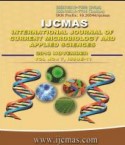


 National Academy of Agricultural Sciences (NAAS)
National Academy of Agricultural Sciences (NAAS)

|
PRINT ISSN : 2319-7692
Online ISSN : 2319-7706 Issues : 12 per year Publisher : Excellent Publishers Email : editorijcmas@gmail.com / submit@ijcmas.com Editor-in-chief: Dr.M.Prakash Index Copernicus ICV 2018: 95.39 NAAS RATING 2020: 5.38 |
Petroleum is a complex mixture composed primarily of aliphatics, alicyclics and aromatic hydrocarbons. This study was to evaluate the potentials of native bacterial population of wastewater environment with the ability for bioremediation of petroleum hydrocarbon polluted natural environment. A fresh water ecosystem west of Lagos state university, Ojo campus that has the history of being fed with both domestic wastewater and spent diesel oil served as source of bacterial samples. Serial dilution technique and total heterotrophic bacterial count for the wastewater was evaluated. The Bonny light crude oil was exposed to the wastewater canal through sterile oil-impregnated filter discs (Type HA 0.45µm diameter) supplemented with dried maize cob housed in perforated plastic balls for 30 days. The physicochemical properties of the freshwater habitat were determined prior to the introduction of oil-impregnated filter discs. Thereafter, residual petroleum hydrocarbons were subjected to Gas chromatography to determine the degree of mineralization of the Bonny light crude. The gas chromatographic profile of the residual crude oil gave the convincing evidence of mineralization of petroleum hydrocarbons by native bacterial population. The petroleum hydrocarbon utilizers were; Bacillus brevis, Pseudomonas sp., Bacillus pumilus, Micrococcus luteus and Corynebacterium sp. The use of native bacterial consortium with petroleum hydrocarbon utilizing capabilities as well as being subjected to biostimulation techniques could prove to be a more environment- friendly approach to bioremediation of oil-polluted environment as well as enhance the processes of sustainable development rather than the use of exotic bacterial species. There were some fungal species isolated and characterized which includes; Aspergillus sp., Penicillium sp., and Fusarium sp.
 |
 |
 |
 |
 |